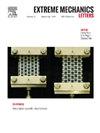极性Willis换能器反设计的压电表变换
IF 4.5
3区 工程技术
Q2 MATERIALS SCIENCE, MULTIDISCIPLINARY
引用次数: 0
摘要
具有精心设计的微观几何结构的压电晶格是构建集成传感器和致动器的强大基石,具有块状材料所没有的通用但非常规的响应。然而,微观几何的逆向设计,以实现一个追捧机电响应仍然难以捉摸。在这里,我们提出了一种称为压电量规变换的分析方法来设计压电晶格换能器,该换能器可以在施加电压时变形为任意所需的位移场。我们首先进行了连续压电计变换,发现变换后的压电材料表现出压电极性和威利斯耦合,即外加电场产生不对称应力和体力,刚体旋转和平移都会产生电荷。为了设计这种极性和威利斯型压电材料,我们开发了离散压电计变换,并提出了可行的点阵设计准则。通过数值仿真验证了压电计变换的有效性,并展示了一系列具有吸引力的位移控制功能。该研究为晶格换能器的反设计提供了一个完整的理论框架,以实现任意期望的驱动位移场,有利于软致动器、机器人和其他压电器件的发展。本文章由计算机程序翻译,如有差异,请以英文原文为准。
Piezoelectric gauge transformation for inverse design of polar Willis transducers
Piezoelectric lattices with delicately designed microscopic geometry are powerful building blocks to construct integrated sensors and actuators with versatile, yet unconventional, responses absent from bulk materials. However, the inverse design of the microscopic geometry to achieve a sought-after electromechanical response remains elusive. Here, we suggest an analytical approach, called piezoelectric gauge transformation, to design piezoelectric lattice transducers that can deform to an arbitrary desired displacement field when a voltage is applied. We first develop continuum piezoelectric gauge transformation and find that the transformed piezoelectric material displays piezoelectric polarity and Willis coupling in the sense that the applied electric field generates asymmetric stress and body force, and both rigid body rotation and translation induce electric charges. To design this polar and Willis-type piezoelectric material, we develop discrete piezoelectric gauge transformation and propose feasible lattice design guidelines. Numerical simulations are performed to validate the piezoelectric gauge transformation and demonstrate a range of appealing displacement control functions. The study presents a complete theoretical framework for the inverse design of lattice transducers to achieve arbitrary desired actuated displacement fields, beneficial to the development of soft actuators, robotics, and other piezoelectric devices.
求助全文
通过发布文献求助,成功后即可免费获取论文全文。
去求助
来源期刊

Extreme Mechanics Letters
Engineering-Mechanics of Materials
CiteScore
9.20
自引率
4.30%
发文量
179
审稿时长
45 days
期刊介绍:
Extreme Mechanics Letters (EML) enables rapid communication of research that highlights the role of mechanics in multi-disciplinary areas across materials science, physics, chemistry, biology, medicine and engineering. Emphasis is on the impact, depth and originality of new concepts, methods and observations at the forefront of applied sciences.
 求助内容:
求助内容: 应助结果提醒方式:
应助结果提醒方式:


